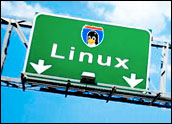
VMware and a group of hardware, software and service providers on Monday announced the Virtual Desktop Infrastructure Alliance to build joint virtual desktop products together. IBM, Hewlett-Packard, Hitachi, NEC, and Sun Microsystems are among the more than 20 companies that make up the new alliance.
Virtualization is a technique for deploying technologies. It allows multiple virtual operating systems to run on a single physical machine while maintaining distinct hardware profiles. In effect, the host operating system executes several guest operating systems.
Desktops are the most underutilized and most difficult to manage IT asset in the enterprise. Today’s business and technology climate has created a new set of desktop management problems such as ensuring data security and privacy within outsourcing and offshoring arrangements and with remote workers as well as ensuring desktop standardization, security and compliance.
“Just as the Web has transformed many applications into a hosted service, virtualization is transforming the entire desktop into a server hosted environment that is always on, dynamically scalable and centrally secured and managed,” said Brian Byun, vice president of products and alliances at VMware.
Collaborating With Rivals
As part of the Virtual Desktop Infrastructure Alliance, VMware plans to collaborate with each member to create, test and integrate joint desktop hosting offerings based on VMware virtual infrastructure and the partner’s hardware or software product. Customers will have the freedom and flexibility to choose their preferred partner and deploy a best in class enterprise desktop solution that meets their business needs.
“Sun is committed to enabling customers to migrate to a more secure desktop environment,” said Alan Brenner, vice president of Sun Client Systems Group. “Sun’s Secure Global Desktop Software and Sun Ray products combined with VMware virtual infrastructure can transform an enterprise by delivering desktop environments and applications with superior security and end-user mobility.”
Building Momentum
Sun’s bit demonstrates one of VMware’s motives behind the alliance: to build momentum behind particular approaches and companies, according to Illuminata analyst Gordon Haff. VMware has hopes to grab market share along with that momentum.
“XenSource has done a lot of publicity in the open source community and VMware is getting very active in making sure that it doesn’t recede into the background in favor of Xen,” Haff told TechNewsWorld. “Xen and VMware have to two key hypervisors in play today.”
Microsoft will presumably introduce its own native hypervisor, but that could be a long way off. Meanwhile, the Xen solution is still somewhat immature, Haff said, and with this alliance VMware is moving to standardize various points within virtualization.
Open Source Competition
Still, open source players seem determined to get a slice of the pie. Red Hat plans to work with AMD, Intel, Network Appliance and XenSource to make virtualization technology a mainstay of the Linux market this year.
Red Hat is developing tools, services and technology previews to allow its customers and partners to deploy computing resources at the lowest possible cost while maximizing the long-term use of each resource.
Novell highlighted its own virtualization plans at its BrainShare conference last month. Those plans unfold with the latest edition of its Suse Linux Enterprise software. Suse Linux Enterprise 10 boasts virtualization enhancements, along with performance and management upgrades.










































